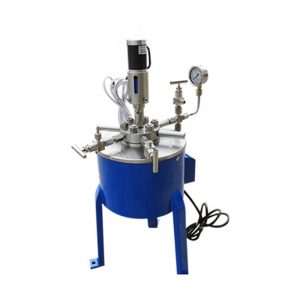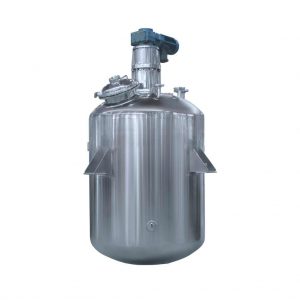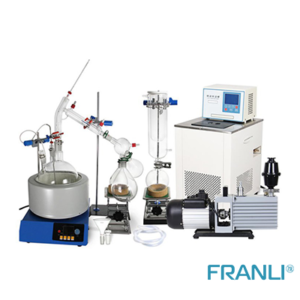Home » What is a Lab Reactor?
What is a Lab Reactor?
Lab Reactor
A lab reactor is at the core of laboratory exercises in various scientific and engineering disciplines. It provides an environment that allows scientists and researchers to conduct experiments and simulations of chemical reactions, which aid in developing new products and optimizing processes.
Details of Chemical Reactor
- Using the latest reaction technology
- It has high temperature resistance, corrosion resistance, and high durability.
- Heating methods include steam, electric heater, high temperature heat transfer oil
- Using jacket, half pipe, fan coil, and other structures
Application: Chemicals, pharmaceuticals, dyes, pesticides, petroleum, food additives, etc.
Types of Lab Reactors
Lab reactors come in different designs and types, each with unique features that make them suitable for a specific application. The following are the most common types of lab reactors.
Batch Reactors – Batch reactors are the simplest type of lab reactors, where a specific quantity of reagents is introduced into the reactor vessel for reaction. The batch reactor’s advantage is that it allows easy control of the temperature conditions in the reactor, as well as providing for sample collection and analysis.
Continuous Stirred Tank Reactors (CSTR) – The CSTR is a versatile reactor that consists of a vertical cylindrical vessel equipped with a stirrer and heating/cooling facilities. It works by allowing the reactants to be continuously fed into the reactor, while the products are continuously removed. The CSTR is efficient in maintaining a constant temperature and concentration of reactants in the reactor.
Plug Flow Reactors (PFR) – The PFR reactor allows the reactants to flow through a narrow, straight tube, offering minimal fluid mixing. As the reactants move along the tube, a chemical reaction occurs between them. One advantage of the PFR is that it allows for precise control of reaction time and is therefore widely used in the production of pharmaceuticals.
Fixed Bed Reactors – these are reactors where the reactants flow through a packed bed of catalyst beads, which induce the required reaction.
Applications of Lab Reactors
Lab reactors have a wide range of applications in scientific research, product manufacturing, and process optimization. Here are some of the areas where these reactors find use.
Pharmaceutical Industry – In the pharmaceutical industry, lab reactors are used to develop new drug compounds that are safe for human consumption. Batch and PFR reactors are commonly employed to synthesize small molecules, while batch reactors exhibit a high level of versatility in the synthesis of different compounds.
Chemical Process Industries – Lab reactors are widely used in the chemical process industries to optimize and study the properties of industrial catalysts. The CSTR is commonly used to study the kinetics of a reaction and the effects of changes in reaction conditions such as pH, temperature, and pressure.
Research – The research sector relies heavily on lab reactors to provide valuable insights into reaction mechanisms and dynamics. They come in handy in analyzing the degradation of organic compounds, synthesizing and characterizing new materials, and determining reaction rates.
Environmental – Lab reactors play a vital role in environmental research, where they are used in the destruction of hazardous wastes, degradation of volatile organic compounds, and reducing greenhouse gas emissions.
Components of Lab Reactors
A lab reactor consists of several components designed to aid in the reaction process, control, and monitoring. These include:
Instrumentation – The instrumentation system in a lab reactor comprises a wide range of sensors, gauges, and controllers that aid in monitoring and regulating the reaction conditions. These include temperature probes, pressure gauges, level sensors, and flow meters.
Stirrer – The stirrer is a vital component that aids in keeping the reactants in the reactor vessel mixed and homogenous.
Reactor Vessel – The reactor vessel holds the reactants and products, along with the stirrer and instrumentation equipment. It is made of materials that are compatible with the reagents and operating conditions, such as glass, stainless steel, and Teflon.
Heating and Cooling Systems – The heating and cooling system in the lab reactor provides the necessary temperature control for the reaction to take place, and for maintaining the reaction conditions.
Maintenance of Lab Reactors
Maintaining lab reactors is crucial to ensure they remain in good working condition and provide reliable results. The following are some maintenance practices that should be observed.
Regular Cleaning – Regular cleaning of the reactor’s interior and exterior surfaces is essential in preventing contamination of reagents and samples.
Calibration – Regular calibration of the temperature probes, pressure gauges, flow meters, and other instrumentation equipment is essential in ensuring the accuracy of the reaction conditions.
Replacing Worn-Out Components – Worn-out components such as stirrers, seals, and gaskets should be replaced to prevent leaks, which can result in contamination of the reaction mixture.
Safety Protocols in Using Lab Reactors
Lab reactors involve working with hazardous chemicals, high-pressure systems, and high temperatures, which pose a significant risk to the operator and the surrounding environment. Here are some safety protocols that should be observed when working with lab reactors.
Personal Protective Equipment – Operators should put on lab coats, gloves, safety glasses, and other relevant protective equipment that would protect them against chemical, thermal, and mechanical hazards.
Proper Storage of Reagents – The storage of reagents should be in labeled, and chemical-resistant containers, in well-ventilated areas away from sources of ignition and heat.
Proper Installation and Operation of Reactors – The reactors should be installed and operated in accordance with the manufacturer’s instructions, or in compliance with industry standards. A licensed engineer should perform any modifications to the reactor system.
Lab reactors play a crucial role in scientific research, product manufacturing, and process optimization. They come in different types and designs with unique features that offer versatility and flexibility in a wide range of applications. Maintaining lab reactors is crucial in ensuring their reliability and accuracy while observing safety protocols when working with these reactors is essential in protecting the operator and the environment.
Welcome to send inquiry to us and let’s make a win win business together !
Guidelines For Chemical Reactor
FRANLI has several complete Chemical reactor production lines. Our Chemical reactor adopts the latest infinitely variable speed reducer device, the sealing device can be a mechanical seal, and the heating and cooling can adopt the structure of a jacket, half pipe, fan coil, etc., The heating methods include steam, electric heater, and high-temperature heat transfer oil to achieve different safe processing environments such as acid resistance, heat resistance, wear resistance, and corrosion resistance.

Laboratory Reactor: Guide to Stirring System
The laboratory reactor is composed of a pot body, a pot cover, an agitator, a jacket, a support and transmission device, a shaft seal device, etc.

Overview of Laboratory Reactor
Laboratory reactors, also known as lab reactors, are essential tools in scientific research, product development, and process optimization. These reactors provide a controlled environment for conducting chemical reactions, mixing, dispersing, and homogenizing processes.

What is A Stainless Steel Reactor?
Stainless steel reactors are essential equipment in various industries, including chemical, pharmaceutical, biotechnology, and food processing.

Glass Reactor & Chemical Equipment
Glass reactors are essential equipment widely used in the chemical, pharmaceutical, and biotechnology industries. They come in various types, suitable for different applications.

Operating Guide for Laboratory Reactors
Laboratory reactors play a crucial role in chemical research and development. Understanding the proper operating procedures is essential to ensure accurate results and maintain a safe working environment.

Glass Reactors and Selection of Stirring Blades
Glass reactors, also referred to as glass reaction vessels, are vessels made from high-quality borosilicate glass material.

